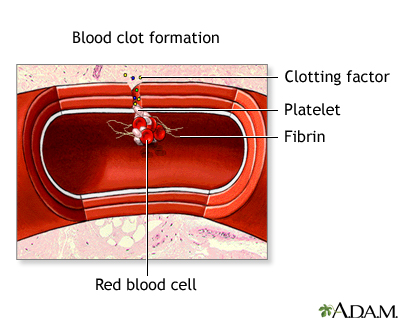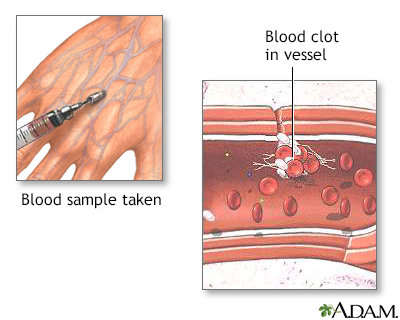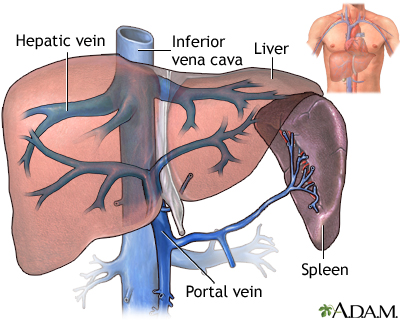Hepatic vein obstruction (Budd-Chiari)
Budd-Chiari syndrome; Hepatic veno-occlusive disease
Hepatic vein obstruction is a blockage of the hepatic vein, which carries blood away from the liver.
Images





I Would Like to Learn About:
Causes
Hepatic vein obstruction prevents blood from flowing out of the liver and back to the heart. This blockage can cause liver damage. Obstruction of this vein can be caused by a tumor or growth pressing on the vessel, or by a clot in the vessel (hepatic vein thrombosis).
Most often, it is caused by conditions that make blood clots more likely to form, including:
- Abnormal growth of cells in the bone marrow (myeloproliferative disorders)
- Cancers
- Chronic inflammatory or autoimmune diseases
- Infections
- Inherited (hereditary) or acquired problems with excessive blood clotting
- Oral contraceptives
- Pregnancy
Hepatic vein blockage is the most common cause of Budd-Chiari syndrome.
Symptoms
Symptoms include:
- Abdominal swelling or stretching due to fluid in the abdomen
- Pain in the right upper abdomen
- Vomiting blood
- Yellowing of the skin (jaundice)
Exams and Tests
One of the signs is swelling of the abdomen from fluid buildup (ascites). The liver is often swollen and tender.
Tests include:
- CT scan or MRI of the abdomen
- Doppler ultrasound of the liver veins
- Liver biopsy
- Liver function tests
- Ultrasound of the liver
Treatment
Treatment varies, depending on the cause of the blockage.
Your health care provider may recommend the following medicines:
- Blood thinners (anticoagulants)
- Clot-busting medicines (thrombolytic treatment)
- Medicines to treat the liver disease, including ascites
Surgery may be recommended. This may involve:
- Angioplasty and stent placement
- Transjugular intrahepatic portosystemic shunt (TIPS)
- Venous shunt surgery
- Liver transplant
Possible Complications
Hepatic vein obstruction can get worse and lead to cirrhosis and liver failure. This can be life threatening.
When to Contact a Medical Professional
Contact your provider if:
- You have symptoms of hepatic vein obstruction
- You are being treated for this condition and you develop new symptoms
Related Information
HepaticTumor
Blood clots
Transjugular intrahepatic portosystemic shunt (TIPS)
Stent
References
Kahi CJ. Vascular diseases of the gastrointestinal tract. In: Goldman L, Cooney KA, eds. Goldman-Cecil Medicine. 27th ed. Philadelphia, PA: Elsevier; 2024:chap 129.
Nery FG, Valla DC. Vascular diseases of the liver. In: Feldman M, Friedman LS, Brandt LJ, eds. Sleisenger and Fordtran's Gastrointestinal and Liver Disease. 11th ed. Philadelphia, PA: Elsevier; 2021:chap 85.
BACK TO TOPReview Date: 5/14/2024
Reviewed By: Jenifer K. Lehrer, MD, Department of Gastroenterology, Aria - Jefferson Health Torresdale, Jefferson Digestive Diseases Network, Philadelphia, PA. Review provided by VeriMed Healthcare Network. Also reviewed by David C. Dugdale, MD, Medical Director, Brenda Conaway, Editorial Director, and the A.D.A.M. Editorial team.

Health Content Provider
06/01/2025
|
A.D.A.M., Inc. is accredited by URAC, for Health Content Provider (www.urac.org). URAC's accreditation program is an independent audit to verify that A.D.A.M. follows rigorous standards of quality and accountability. A.D.A.M. is among the first to achieve this important distinction for online health information and services. Learn more about A.D.A.M.'s editorial policy, editorial process and privacy policy. A.D.A.M. is also a founding member of Hi-Ethics. This site complied with the HONcode standard for trustworthy health information from 1995 to 2022, after which HON (Health On the Net, a not-for-profit organization that promoted transparent and reliable health information online) was discontinued. |
The information provided herein should not be used during any medical emergency or for the diagnosis or treatment of any medical condition. A licensed medical professional should be consulted for diagnosis and treatment of any and all medical conditions. Links to other sites are provided for information only -- they do not constitute endorsements of those other sites. © 1997- 2025 A.D.A.M., a business unit of Ebix, Inc. Any duplication or distribution of the information contained herein is strictly prohibited.
